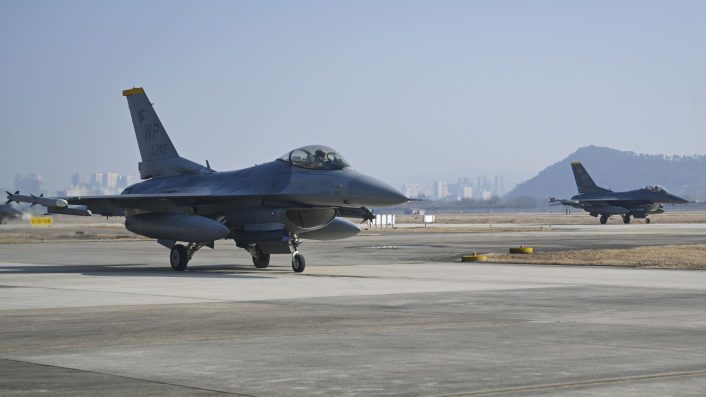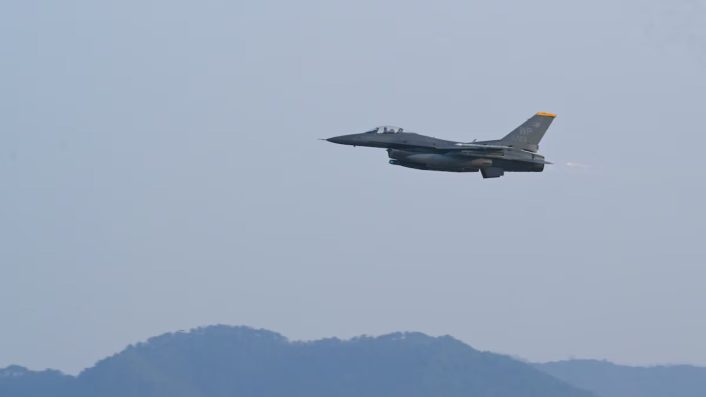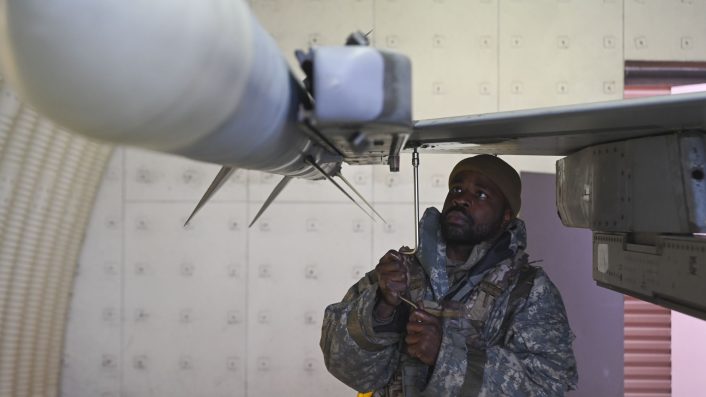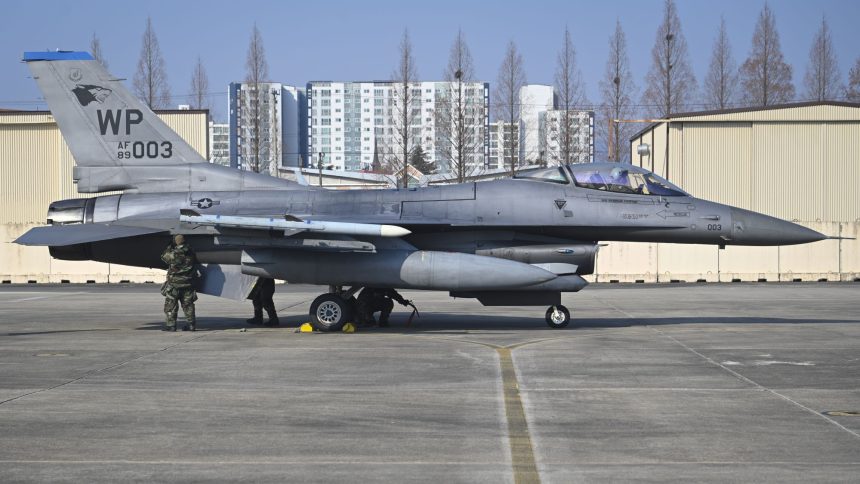Beverly Pack 25-1 tested the Wolf Pack’s ability to deploy Airmen, equipment, and aircraft to a simulated forward operating base (FOB) at Gwangju Air Base from Kunsan Air Base. Simultaneously, units at Kunsan responded to a variety of hostile threats while providing necessary support to the FOB.
The U.S. Air Force’s exercise Beverly Pack (designated 25-1) in South Korea this year, held from Jan. 12 to Jan. 16, 2025, saw the 8th Fighter Wing (8th FW) at Kunsan, executing it’s “first” ACE (Agile Combat Employment) movement on the Korean Peninsula, by “deploying to a simulated forward location at Gwangju Air Base,” PACAF (Pacific Air Forces) said. The Kunsan based 8th FW oversees the 80th Fighter Squadron (FS) and the 35th FS, both of which operate the F-16.
The 8th FW, also called the “Wolfpack”, routinely features in dissimilar combat training with other aircraft types and the RoKAF (Republic of Korea) KF-16s all around the year. The latest instalment of the Bev Pack however marks the Wolf Pack’s “innovative approach to projecting airpower for the first time on the Korean Peninsula,” the Seventh Air Force added in a statement. Another major South Korea-based formation is the 51st FW at Osan, under which the 25th FS and 36th FS, fly the A-10 Thunderbolts and the F-16C/D Block 40, the former of which should begin their retirement from the country this year.

It would be pertinent to note that 8th FW F-16s have operated from Gwangju prior to this in drills like the Korea Flying Training, an annual “combined training event focused on tactical execution of combat missions.” This was however not an ACE exercise. Bev Pack 25-1 had the actual flying of fighters from one base to another dispersed, austere location along with all the support elements, and not just the base-level and not just the logistical, maintenance and load crew drills that are undertaken to support ACE maneuvers. Based on the official images, we can count two F-16s at Gwangju from Kunsan.
During Bev Pack 25-1, Airmen executed a historic 1st ACE movement on the Korean Peninsula, deploying to a simulated forward location at Gwangju AB. ✈️ Proving their ability to sustain combat ops in austere conditions, ensuring a resilient #FreeAndOpenIndoPacific. @KunsanAirBase pic.twitter.com/Rek00qw1TU
— PACAF (@PACAF) February 7, 2025
First ACE during Bev Pack 25-1
ACE involves operating from non-traditional air bases and airfields, with minimal supporting infrastructure, facilities, with a view to keep the operations dispersed and deconcentrated from large, single military locations. While these might invite conventional land-attack cruise and ballistic missile strikes, ACE operations entail an adversary to simultaneously fire more number of such missiles (possibly numbering into hundreds), that depletes their stockpiles. Likewise, ACE also allows strike aircraft to hold enemy targets at risk from multiple locations, presenting targeting dilemmas.
In Beverly Pack 25-1, the run up to the kick-off from Jan. 10, 2025 featured images and information about Fighter Generation Squadrons preparing F-16s; Logistics Readiness Squadrons carrying out cargo deployment; F-16 aircraft undergoing decontamination (a nuclear radiation scenario relevant to North Korea); and security forces defending the base from ground and drone attacks.
Other non-core combat support functions comprised MRE (Meals Ready-To-Eat) inspections, where personnel were taking a stock of the inventory. MREs naturally fit into the ACE as the packaged meals eliminate the need for field kitchens that entail additional personnel, infrastructure and basing. Members of the 8th Operational Readiness Squadron inspected “ready-to-eat” pallets for “contaminants after a simulated air attack.”

‘Bringing all elements together’
A release said how the drills were the results of “months” of “planning” and bringing together the smaller-scale components and elements that the air and ground crews practiced. 8th FW commander, Lt. Col. Peter “Wolf” Kasarkis, said they had “done part-task training but have not put all the pieces together in one coherent, operationally relevant timeline to discover the gaps and seams as one wing.”
Building upon the lessons gained from Exercise Beverly Sentinel 25-1 in Nov. 2024, Bev Pack 25-1 “tested the Wolf Pack’s ability to deploy Airmen, equipment, and aircraft to a simulated forward operating base (FOB) at Gwangju Air Base.” Simultaneously, units at the main operating base were tested on their ability to respond to a variety of hostile threats while providing necessary support to the FOB.
During Exercise Beverly Sentinel 25-1 in Nov. 2024, the 8th Logistics Readiness Squadron and the 8th Force Support Squadron worked with the 8th FW to measure the “execution of Cargo and Personnel Deployment Function timelines, highlighting the importance of coordination between the Installation Deployment Readiness Center and Unit Deployment Monitors across the Fighter Wing.”

The elements involved “unit-specific skills, including emergency operations, crisis action team coordination, general arming procedures, mass casualty response, tactical combat casualty care, and weapons training.” But the primary goal during the ACE exercise at Kunsan during the Beverly Sentinel 25-1 was “ensuring that all cargo and personnel are processed properly to deploy to their disclosed location.”
Capt. Trevor “KAOS” Hellberg, the 8th FW’s director of exercises, stressed upon training under “extremely realistic and difficult conditions” and “sustain” combat in a “long-term contested environment and deliver consistent, credible airpower to U.S. Forces Korea.” “Through actioning complex, realistic ACE training, the Wolf Pack is enhancing its warfighting advantage and its ability to project airpower in the Indo-Pacific’s complex strategic environment.”
Movement for ‘mission generation’
Images released on the DVIDS network showed two F-16s arrive at Gwangju Air Base, carrying at least one inert AIM-120 AMRAAM (Advanced Medium-Range Air-to-Air Missile) on the wingtip of the right wing, and an AIM-9X Sidewinder on the outer hardpoint of the left wing.
💪 Sets n’ Reps
Squadrons at @KunsanAirBase honed unit-specific skills including emergency ops, crisis action team coordination, arming procedures, tactical combat casualty care, & weapons training during Exercise Beverly Sentinel 25-1.
More details here 👇… pic.twitter.com/6XvxChAhWO
— U.S. Air Force (@usairforce) November 24, 2024
The PACAF release quoted 1st Lt. Charles Burns, saying they exercised their “dispersal capabilities by taking a small detachment from our main operating base and moving them here for a short period of time to execute contingency [operations].” The pictures showed a wingtip screw on the F-16 being tightened and a load crew member unloading an air-to-ground munition. The stress was on “mission generation”, which involves rapidly readying platforms and weapons in sudden military contingencies.
1st Lt. Burns added:
“Based on intelligence, we would know when enemies will be attacking certain locations, so we could take our forces and move them to different locations to continue to have the capabilities to send combat sorties and continue to disrupt the enemies without ourselves being disrupted.”
“We are accomplishing ACE on [one] level, and additionally stress-testing the Mission Generation Force Element concept,” said U.S. Air Force Senior Master Sgt. Shelley Schofield, ACE detachment senior enlisted leader. “This has led us into a larger package of mission generation capability – we are able to fix aircraft more in depth based off the things and people we brought with us here.”









